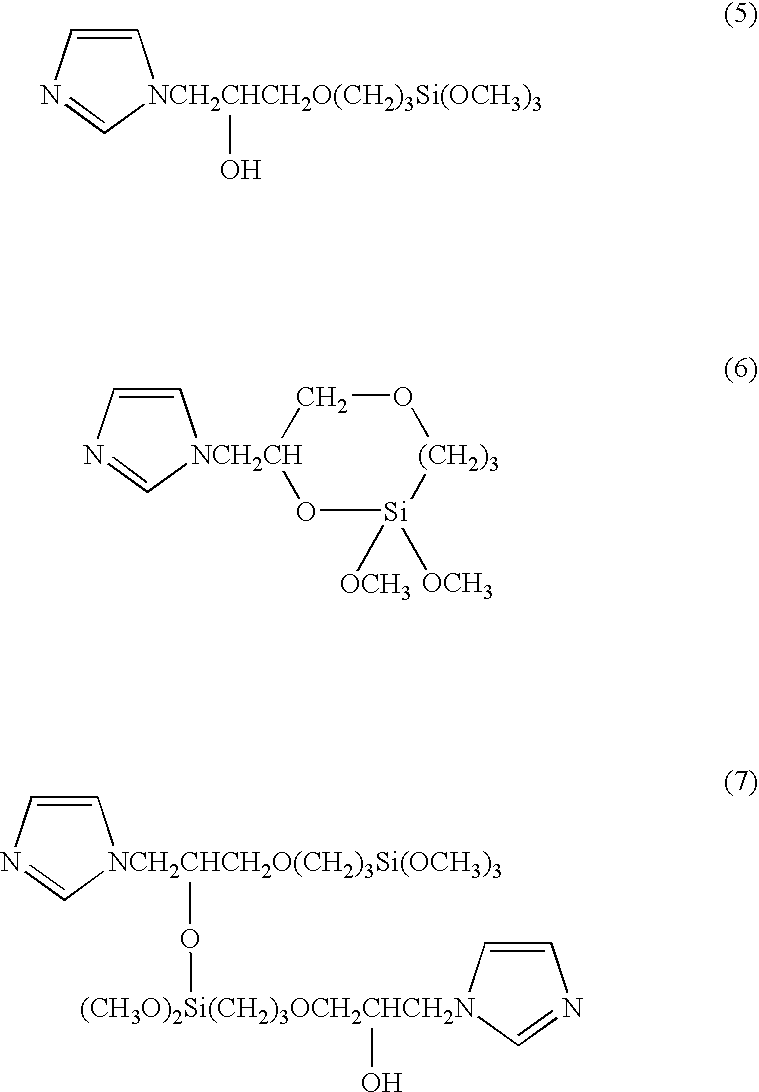Basic silane coupling agent organic carboxylate composition, method for producing the same, and epoxy resin composition containing the same
a technology of organic carboxylate and silane coupling agent, which is applied in the direction of silicon organic compounds, epoxy resin coatings, group 4/14 element organic compounds, etc., can solve the problems of poor storage stability and disadvantages ofimidazole group-containing silane coupling agents, and achieve stable and long working life
- Summary
- Abstract
- Description
- Claims
- Application Information
AI Technical Summary
Benefits of technology
Problems solved by technology
Method used
Image
Examples
example 1
[0030] 13.62 g (0.2 mol) of imidazole was melted at 95° C., and 47.27 g (0.2 mol) of (3-glycidoxypropyl)trimethoxysilane was added dropwise thereto over a period of 30 minutes while stirring in an argon atmosphere. Following the addition, the product was further reacted for one hour at a temperature of 95° C., yielding an imidazole group-containing silane coupling agent comprising a mixture of the compounds represented by the chemical formulas (5), (6), and (7) below. 30.4 g (0.1 mol) of the imidazole group-containing silane coupling agent thus obtained and 25.4 g (0.1 mol) of pyromellitic acid were heated and mixed at 120° C., and an imidazole group-containing silane coupling agent pyromellitate was obtained by continuing the reaction for one hour. 20.8 g of phenol resin (Phenolite TD-2093 having a softening point of 100° C., mfd. by Dainippon Ink and Chemicals, Inc.) was added to this carboxylate, the product was heated and mixed for one hour at 120° C., and an imidazole group-con...
example 2
[0031] 30.4 g (0.1 mol) of an imidazole group-containing silane coupling agent obtained in the same manner as in Example 1 and 21.0 g (0.1 mol) of trimellitic acid were heated and mixed at 120° C., and an imidazole group-containing silane coupling agent trimellitate was obtained by continuing the reaction for one hour. 31.2 g of phenol resin (Phenolite TD-2093 having a softening point of 100° C., mfd. by Dainippon Ink and Chemicals, Inc.) was added to this carboxylate, the product was heated and mixed for one hour at 120° C., and an imidazole group-containing silane coupling agent trimellitate / phenol resin composition that was a solid at normal temperatures was obtained by cooling the product to room temperature. The solid product thus obtained was ground with a mortar and classified by a sieve with hole openings of 90 microns to yield pulverized Sample No. 2.
example 3
[0032] 30.4 g (0.1 mol) of an imidazole group-containing silane coupling agent obtained in the same manner as in Example 1 and 16.6 g (0.1 mol) of phthalic acid were heated and mixed at 120° C., and an imidazole group-containing silane coupling agent phthalate was obtained by continuing the reaction for one hour. 41.6 g of phenol resin (Phenolite TD-2093 having a softening point of 100° C., mfd. by Dainippon Ink and Chemicals, Inc.) was added to this carboxylate, the product was heated and mixed for one hour at 120° C., and an imidazole group-containing silane coupling agent phthalate-phenol resin composition that was a solid at normal temperatures was obtained by cooling the product to room temperature. The solid product thus obtained was ground with a mortar and classified by a sieve with hole openings of 90 microns to yield pulverized Sample No. 3.
PUM
| Property | Measurement | Unit |
|---|---|---|
| melting point | aaaaa | aaaaa |
| temperature | aaaaa | aaaaa |
| temperature | aaaaa | aaaaa |
Abstract
Description
Claims
Application Information
 Login to View More
Login to View More - R&D
- Intellectual Property
- Life Sciences
- Materials
- Tech Scout
- Unparalleled Data Quality
- Higher Quality Content
- 60% Fewer Hallucinations
Browse by: Latest US Patents, China's latest patents, Technical Efficacy Thesaurus, Application Domain, Technology Topic, Popular Technical Reports.
© 2025 PatSnap. All rights reserved.Legal|Privacy policy|Modern Slavery Act Transparency Statement|Sitemap|About US| Contact US: help@patsnap.com



